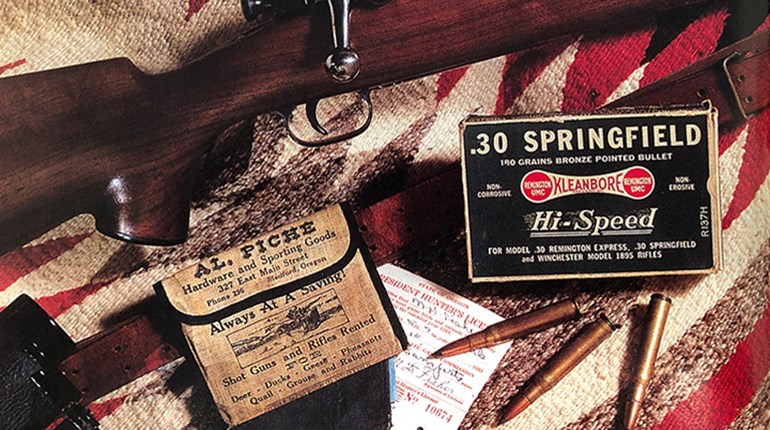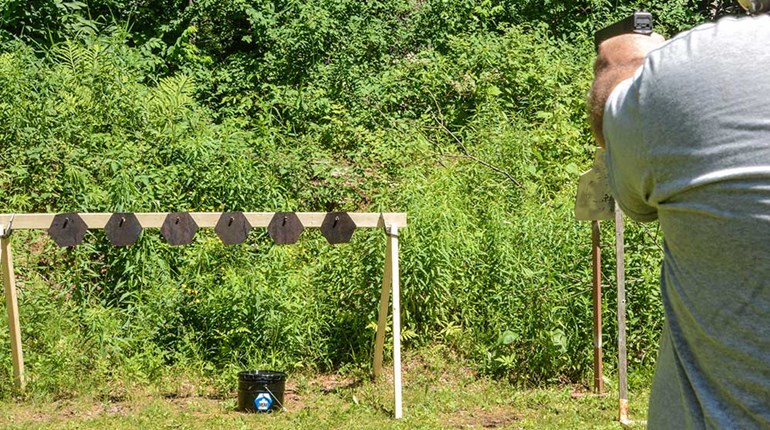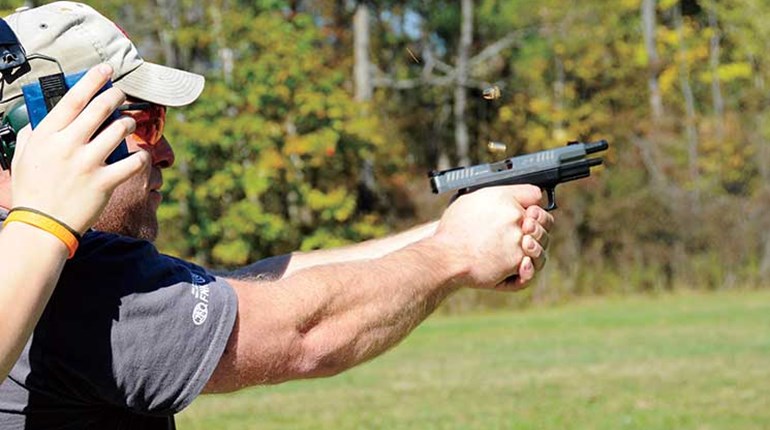In Chapter 23 of my novel, The 14th Reinstated, the protagonist follows a wounded whitetail for miles through the bitter cold. He chases the buck over a mountain range and down the other side to a river choked with anchor ice formed in temperatures hovering below zero. He crosses the river three times while tracking the wounded buck, and nearly drowns in the process. It was a tough, brutal day of bitter cold and bitter disappointment, and it actually happened to me. That chapter was based on a true story. I tracked that buck nearly 10 miles over two days before I managed to finish the job.
What I don't say in the book is that it was a very small buck. In my part of the world any legal buck is a trophy and he met the requirements, but just barely. When telling the whole story the first reaction I often get from people is, "You did all that for a spike?"
That tends to get my "Towsley" up, and I quickly set them straight on one point I believe very strongly: You owe your best effort to any animal you wound. It's your responsibility to put forth every possible effort to finish the job you started. If it was big enough for you to shoot at, then it's big enough for you to clean up your mess when things don't go according to plan.
The second point of that story is, never give up. Stay on the hunt until you exhaust every possibility, and then look a little more. It's the ethical and moral thing to do.
The "Tracking Wounded Deer" article is a staple of outdoor writers and has almost become a cliché. It's been written to death, and while most of what is repeated over and over is useful, it also tends to be limited. This article gets past the "look at the color of the blood to figure out where you hit the deer and hang toilet paper in bushes to mark the sign" school of thought and offers some advanced suggestions. Grid searches, circling to locate trails, waiting at least six hours to follow up a gut shot and all the rest of the basics still apply, but if you know and practice these things already, here are a few more off-the-wall suggestions that may help you take the search for wounded game to the next level.
Get Stubborn
Part of success can be found in the psychology of finding wounded game, as illustrated by my first point. Persistence is important. Some years back I shot a Lichtenstein's hartebeest in Tanzania with a borrowed .416 Remington. He ran off, but I was sure of my shot. We followed for hours and the "trackers" never found blood, but they claimed they found something that was from the stomach, indicating a gut shot, so I had to pay the trophy fee no matter the outcome.
I shot the bull at first light, and we finally quit for a late lunch. Everybody was convinced I had muffed the shot, except me. They all wanted to just move on and hunt buffalo that afternoon, but I got stubborn. Although nobody would listen to me, I knew they were looking in the wrong place.
I got tired of arguing, so I just grabbed my rifle and went back to look. They could follow or not, I didn't care. Once everybody calmed down, the PH decided to humor me and he sent the trackers in the direction I wanted to look. We found the bull dead 200 yards from where I shot him with a bullet hole though his shoulder and nowhere near his guts.
If I had not been stubborn about looking again, things would have turned out much differently. Don't ever be quick to give up. Sometimes taking a break can clear your head and change your luck, but don't use it as an excuse to quit.
Stick with it even after you think it's hopeless.
Believe in Yourself
Don't let others talk you out of what you know is true. If you know you made a good shot, you probably did. I once shot a whitetail buck while being filmed for a video by a famous camo company. We were using some new ammo with polymer-tipped, softly constructed bullets, and the shot was end-to-end on a large buck. That means a tiny entry hole and no exit, with little or no blood trail.
We looked for a little while but never found any blood. The "experts" reviewed the footage and decided I missed. I was a guest on the hunt and went along to get along. Two days later the buzzards were circling not far from where we were looking. The buck had dropped dead in mid-stride, seconds after the shot.
Don't Trust Your Eyes
This is a bit contrary to the last advice, but nothing is absolute when tracking wounded game. In a former life, I did a lot of spring bear hunting. I was a booking agent, and at one camp we used, the outfitter was scared of the bears and clueless about tracking. So, as a result, I helped track a lot of wounded bears. Time and again we would look where the hunter claimed the bear ran and not find a thing. But by looking around we often found a blood trail in a different location. The hunter always claimed at first that it wasn't his bear, but was usually pretty happy to put a tag in its ear.
The point is, the mind plays tricks when it's excited. Shooting at big game is a very stressful time, and often we remember things that just aren't so. It's important to watch after the shot, but excitement can distort things pretty badly, so don't always trust anybody's eyes. If you can't locate a blood trail, you might be looking in the wrong place.
Open up a wider search.
Nobody is immune. I once shot a nice deer in an Alabama greenfield just at last shooting light. I watched it run back to the woods and marked the spot in my mind. I looked for some time and found nothing. My ride showed up with more people, and we looked for another hour. We were all hungry and tired, and I was embarrassed and upset. There was a lot of gambling about a miss, but I knew the shot was good.
In desperation, and to get away from all the negative voices, I started walking the edge of the field looking for blood. A full 100 yards from where I was sure that deer ran I found a wide-open blood trail. The deer was just inside the woods and as dead as Obama's credibility.
To this day, I have no idea how I made that mistake. The lesson: Always look everywhere. Often the most impossible option is the right one.
It's Not a Social Event
Like it or not, if you are good at tracking wounded game, you hardly ever lack a date for Saturday night in the fall. I had already been asleep for an hour when the phone rang. A family member had stuck an arrow in a buck and needed help finding it, so I suited up and rode to the rescue.
I had no trouble finding the person as it looked like a party was going on. There were people everywhere: wives, lovers, kids, neighbors, brothers, sisters and even a homeless guy who heard they had free beer. There were so many flashlights it looked like the mountain was decorated for Christmas.
The thinking was the more eyes looking, the better the chances. The family member had flooded the woods with people looking for the deer and, as a result, all but ensured it would be lost. They trampled any sign we had available to follow and, with all the yelling back and forth, had alerted the deer that it was time to move to a less popular place.
We finally sent everybody home. The next morning the two of us returned.With a lot of luck we found the blood trail and finally after several hours, the deer.
Keep the party small. Use only experienced trackers, people who know enough to walk to the side of the trail so they don't step on the sign, people who understand the process and can stay on point. Two is good, three is better, more than that is usually too much.
Too often the guys helping just don't have enough invested, and they get bored or frustrated. They start to wander and crash around without really looking. They will walk on the sign, covering up the blood or tracks. I have even seen such people get lost, which creates a whole new set of problems and distracts from finding the deer.
Keep it small, keep it focused and keep it on mission. Pick the right people. Nobody wants to admit they don't know what they are doing; egos often lead to problems. You wind up with too many type-A personalities trying to take charge and prove they are the best tracker. Use people who know what they are doing and don't need to prove it, or people who will at least listen to and follow instructions.
Be Quiet
Don't do a lot of shouting back and forth when you are tracking a wounded animal. If it is still alive, the shouting will inspire it to get up and run away. At the very least it lets the game know where you are and alerts it to your approach.
We were tracking a wounded nilgai recently in South Texas. It had run into a small patch of trees and not exited. My plan was to quietly sneak in and finish what I started, and it would have worked. But the guide started blathering on the radio, telling everybody what we were doing. We were close, and the bull decided to run for it. From there it really turned into a cluster. I got him, finally, long after I should have.
You are still hunting this critter, so act like it. It's much better to sneak up and finish the animal in its bed than to jump it and run it to exhaustion.
Become the Deer
Nothing to follow? The most frustrating time in tracking a wounded animal is when you simply run out of blood or tracks.
If the deer has been traveling in a specific direction for a while, continue with that. Or, you can return to the last couple of places you found sign and line them up, which gives you a direction of travel. So travel. Walk along while thinking, "If I were a wounded deer, which way would I go?" Just follow your instincts. You may have to return to the last sign and strike out in another direction a few times, but sooner or later the odds are you will find a new spot of blood or an identifiable track that puts you back in the game.
That's how I followed the 10-mile buck much of the time. I knew his general direction of travel, and I just followed the natural travel corridors though that mountainous terrain. There were a couple of times when I didn't find any sign for half a mile or more. I trusted my instincts, and it paid off.
Turn Off Your Brain
Another approach: Turn off your brain and just walk. Let the terrain and vegetation guide your feet. Deer and other animals will take the path of least resistance, and if you walk in a "Zen" state, going with the flow, you will find you do the same thing. Once you get in tune with the woods, things like that just happen in the back of your mind. If you try to think about it too much, you screw it up, but if you just let the reptilian part of your brain operate, then eons of evolution are suppressed. The caveman in you will come out of hiding and turn you into a creature of the woods, just like the deer.
I know it's a bit too "new age," but I have found several animals in situations thought to be hopeless using this technique.
Light the Way
If you have read any articles on tracking wounded game then you have no doubt read that a Coleman lantern "makes blood glow like neon." Or you have probably read about how this color or that color filter on a flashlight will make blood show up better. Sometimes I wonder if any of those writers actually do the things they suggest.
The lantern does show blood a bit better than a conventional flashlight, but it's always been a disappointment to me when I have used one. The other problem: Who has a Coleman lantern in his backpack? The flashlight filters just cut the amount of light until it's hard to see anything.
But there is a tool that shows blood like it's electrified: the original incandescent bulb, Surefire-style flashlight. While such units are being phased out and replaced by much more energy-efficient LED lights, they are still sold. It's a good idea to have one in your pocket or backpack when hunting.
They truly do make blood "glow" and are the best light I have ever found for tracking. But not just at night: They work at dusk or dawn and even on those gloomy fall days.
I was tracking a deer that was hit poorly with a muzzleloader. It turned out to be a tough tracking job through some very thick Iowa bottomland. As the light faded, I lost the trail again.
I was just walking, much like described in the previous section, and not sure where the deer had gone. It was still light enough to see pretty well, but I wanted to make sure my flashlight worked in anticipation of darkness. I took out my light and shined it on the grass, and was shocked to see several tiny pinpoints of blood that had fallen deep into the matted grass and vegetation. They were too small to see with the naked eye in the ambient light and for the most part were down in the grass rather than on top. I turned off the light and saw nothing, turned it back on and it was like I was looking at the Milky Way—only instead of stars I saw what had to be misted blood that had all fallen down into the grass, with the trail going off in a direction I never suspected. I followed for a little bit, and there was the dead deer.
In the years since, I have used a flashlight even when there's still enough daylight to see blood. I can't count the times I have found blood with the flashlight when I was sure there was none to be found.
The new LED lights are pretty good as well, but they're nothing like the models with incandescent bulbs. Those incandescent flashlights eat batteries like candy and get so hot they'll char your gloves, but nothing else works as well to find blood.
Change Perspective
Get low. The recent passing of a deer will scuff up the leaves. Older tracks will settle from time and gravity, but a fresh track will still show a bit higher. It's usually not noticeable when standing above it, but when you get your eyes to ground level often you can see the trail very clearly.
Get Outside the Box
I hate overused clichés, and this one is so worn out it's parodied in TV commercials. But it fits. When tracking wounded game, you need to move outside the "looking for blood on the ground" box.
We tend to get focused on looking for blood and forget the animal can leave other sign, often sign that is unique to it alone: the length of the track or stride, the shape of the foot, how one foot hits the ground differently than another. Look for these things, not just for a blood trail.
It's pretty common to look so intently for blood on the ground that you overlook the blood on the trees and bushes above the ground. While the blood may not be dripping, what's mixed in the animal's hair can rub off on bushes and branches as it passes. If the animal bends the grass or bushes as it passes, the blood can be much higher than you expect. Look everywhere.
Find something different. There is almost always something unique to the critter you are trailing. A good example is that 10-mile buck I tracked. Because of his wounds he had a unique right-front foot track, particularly when he was going downhill. His left side was hurt, and so his right-front foot was taking more of his weight and it hit a bit harder than normal. As a result of the limp, I was able to pick out his track even when there were lots of other deer tracks.
Another time, we were tracking a deer and had pretty much given up after losing the trail. On the way back to the truck we came to a small stream, and I noticed there was water on top of one of the rocks. The deer had crossed and had dripped a little water on the otherwise dry surface. That led to finding another spot of blood 50 yards past the stream and finally to finding my first ever bow-shot whitetail.





































